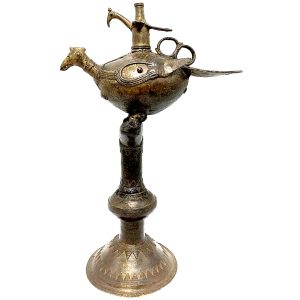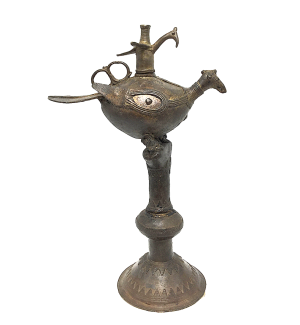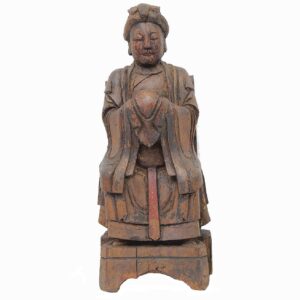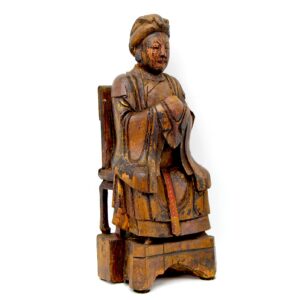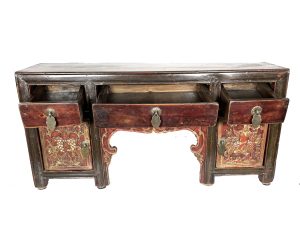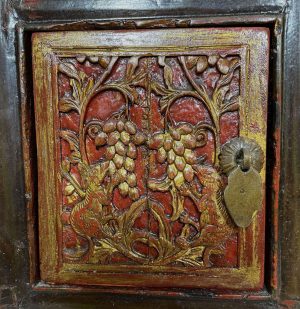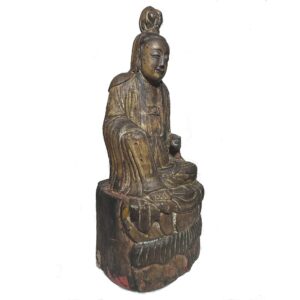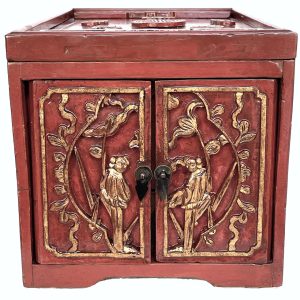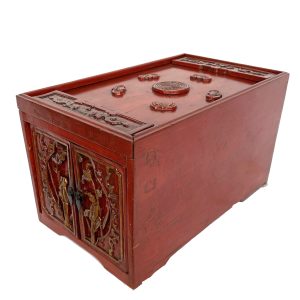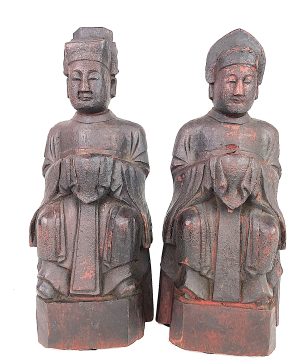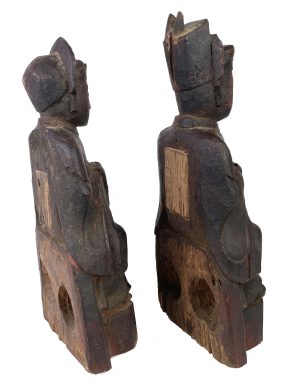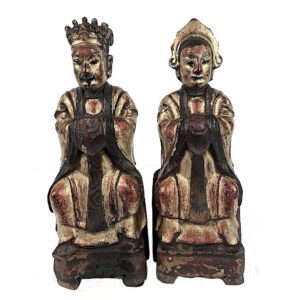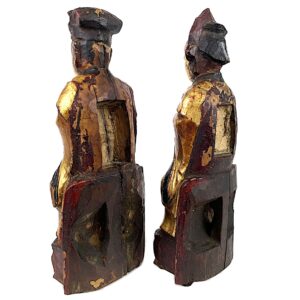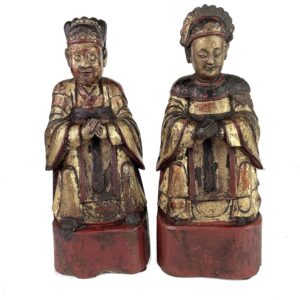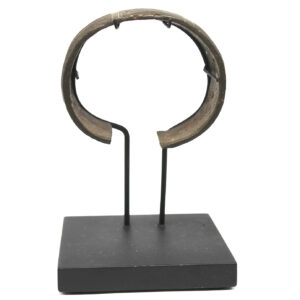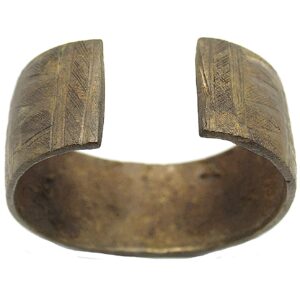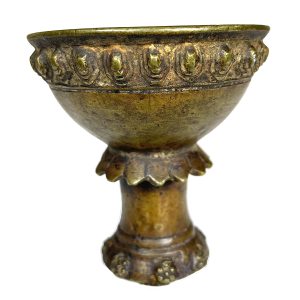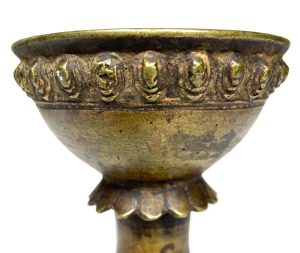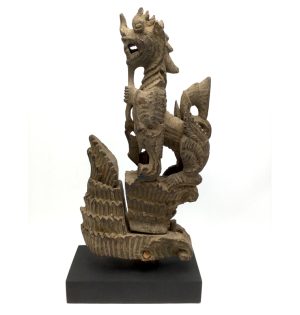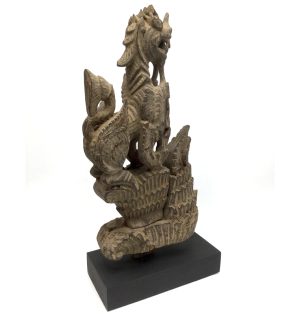Showing 49–60 of 200 results
-
Sale!


$365.00 Original price was: $365.00.$325.00Current price is: $325.00.
H: 13″ W: 8.5″ D: 4.75″ | CALL 213-568-3030 OR EMAIL [email protected] FOR SHIPPING.
Graceful peacock oil lamp for Hindu ritual home altar prayers signifying purity, virtuosity, goodness, good luck. Large peacock is reservoir for oil, smaller peacock the lamp’s lid. Peacocks symbolize love, joy, peace and harmony.
-
Sale!


$425.00 Original price was: $425.00.$225.00Current price is: $225.00.
H: 9” W: 6.525” D: 2.5 | FREE SHIPPING WITHIN CONTINENTAL U.S.
Small consecrated home altar provincial Mazu, finely carved on armless back chair dressed modestly in peasant robes with a phoenix in her hat, she is motherly figure who protects her devotees as her children.
-
Sale!


$585.00 Original price was: $585.00.$395.00Current price is: $395.00.
H: 9″ W: 18.5″ D:5.8″ | CALL 213-568-3030 OR EMAIL [email protected] FOR SHIPPING.
Small table probably was in young couple’s bedroom as a wish for a prosperity, health, and many sons. Panels with Guanyin on a hǒu holding lotuses and rats with melons as fertility symbols. Perfect personal home altar or wedding gift.
-
Sale!


$885.00 Original price was: $885.00.$695.00Current price is: $695.00.
H: 13.75″ W: 6″ D: 4.8″ | FREE SHIPPING WITHIN CONTINENTAL U.S.
White Hooded provincial Guanyin in lalitsana depicted as humble with a plain hood, gentle smile, holding a scroll symbolizing the Buddhist sutras in which she is mentioned including the Lotus Sutra Chapter 25.
-
Sale!


$385.00 Original price was: $385.00.$325.00Current price is: $325.00.
Ht: 8.5” W: 15” D: 9” | CALL 213-568-3030 OR EMAIL [email protected] FOR SHIPPING COST
Given the auspicious images on this finely crafted red and gilt jewelry box -a lotus and 5 bats surrounding a longevity roundel, it was probably a wedding gift for a fortunate couple as a wish for longevity, fertility, harmony and many and sons.
-
Sale!


$650.00 Original price was: $650.00.$495.00Current price is: $495.00.
H: 9.75″ W: 7″ D: 6″ | CALL 213-568-3030 OR EMAIL [email protected] FOR SHIPPING.
Ancestor figure is finely depicted as loved family member, individualized pudgy joyful smiling face. Displays strength and status by his demeanor, composure, portly size, and elaborate horseshoe chair. On lucite stand, a wonderful accessory for a home or business.
-
Sale!


$695.00 Original price was: $695.00.$525.00Current price is: $525.00.
H: 7.25 ” W: 3 ” D: 1.625 ” | FREE SHIPPING WITHIN CONTINENTAL U.S.
Finely carved Kitchen God and his wife, mirror images on backless chairs with multi-sided pedestals reflecting reverent and responsibility to protect the home. Naturally darkened lacquer, soft patina. Male with consecration covering, female open with contents. Unique house warming/wedding gift.
-
Sale!


$695.00 Original price was: $695.00.$525.00Current price is: $525.00.
H: 7.75 ” W: 2.875 ” D: 1.875 ” | FREE SHIPPING WITHIN CONTINENTAL U.S.
Husband and wife Kitchen Gods are near mirror images with similar layered gold officials’ robes, clasped hands covered in ritual cloth. Excellent condition, fine patinas. Consecration script remaining in wife’s cavity but not in husband’s.
-
Sale!


$785.00 Original price was: $785.00.$625.00Current price is: $625.00.
H: 7.75″ W: 3.25″ D: 2.375″ | free shipping within Continental U.S.
Finely carved this Kitchen God and his Wife monitor family members from their perch above the stove. Near mirror images with layered gold officials’ robes they symbolically hold tablets to report about the family to the Jade Emperor on Chinese New Year. enhance feng shui. Kitchen Gods especially pairs are now rare and very collectible and make unique wedding and house gifts.
-
Sale!


$115.00 Original price was: $115.00.$90.00Current price is: $90.00.
H: 2.875” W: 3.25” Width: 1.5” | FREE SHIPPING WITHIN CONTINENTAL U.S.
This antique manilla is made by the Kota in the northeastern region of Gabon and Congo. A thin wide C-shaped bracelet with an elaborate five section design, each section has unique designs with long striations, grooved crosshatches, long triangles and angled designs. In very good condition with minor losses, pitting and scratches, its rough surface inside is consistent with its age and use and comes with a wood and metal stand.
-
Sale!


$295.00 Original price was: $295.00.$220.00Current price is: $220.00.
H: 3″ D: 3.8″ | FREE SHIPPING WITHIN CONTINENTAL U.S.
Decorative brass container to hold kumkum powder used in Hindu rituals and ceremonies. Made into a paste to apply a tikka, decorated with lotus leaves, floral patterns and decorative rim.
-


$325.00
H: 14.5” W: 17.75” D: 3.375” | FREE SHIPPING WITHIN CONTINENTAL U.S.!
Finely carved figures were attached to ox cart yokes to protect farmers from malevolent spirits who inhabited all seen/unseen sectors of their world. . This beautifully carved ox cart yolk image is a chinthe, a mythical Burmese lion/dragon creature commonly decorating many everyday items. A propitious spiritual and protective guardian, the animalsymbolizes power, courage, and strength. This carving displays the common traits of a lions with a long face, large eyes, a long sharp nose, a lion-like beard, and a flame-like shape on the top of his head. Masterfully carved with careful attention to details, see the deeply incised hairs that cover his body. The 2-part piece is held together with a wooden plug. Though for daily use, Burmese craftsmen created beautiful objects and finished them with the best materials they could afford.
End of content
End of content

